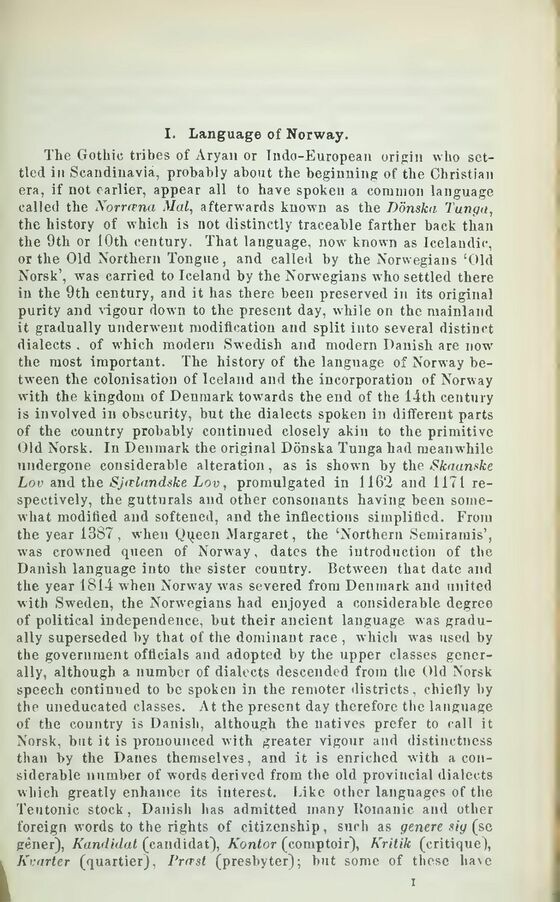
Full resolution (JPEG) - On this page / på denna sida - Sketch of Norwegian and Swedish Grammar, with Vocabulary and List of Phrases - I. The Language of Norway

<< prev. page << föreg. sida << >> nästa sida >> next page >>
Below is the raw OCR text
from the above scanned image.
Do you see an error? Proofread the page now!
Här nedan syns maskintolkade texten från faksimilbilden ovan.
Ser du något fel? Korrekturläs sidan nu!
This page has never been proofread. / Denna sida har aldrig korrekturlästs.
The Gothic tribes of Aryan or Indo-European origin who
settled in Scandinavia, probably about the beginning of the Christian
era, if not earlier, appear all to have spoken a common language
called the Norreena Mai, afterwards known as the Dönska. Tunga,
the history of which is not distinctly traceable farther back than
the 9th or 10th century. That language, now known as Icelandic,
or the Old Northern Tongue, and called by the Norwegians ‘Old
Norsk’, was carried to Iceland by the Norwegians who settled there
in the 9th century, and it has there been preserved in its original
purity and vigour down to the present day, while on the mainland
it gradually underwent modification and split into several distinct
dialects . of which modern Swedish and modern Danish are now
the most important. The history of the language of Norway
between the colonisation of Iceland and the incorporation of Norway
with the kingdom of Denmark towards the end of the 14th century
is involved in obscurity, but the dialects spoken in different parts
of the country probably continued closely akin to the primitive
Old Norsk. In Denmark the original Dönska Tunga had meanwhile
undergone considerable alteration, as is shown by the Fkaunske
Lov and the Sjalandske Lov, promulgated in 1162 and 1171
respectively, the gutturals and other consonants having been
somewhat modified and softened, and the inflections simplified. From
the year 1387, when Qqeen Margaret, the ‘Northern Semiramis’,
was crowned queen of Norway, dates the introduction of the
Danish language into the sister country. Between that date and
the year 1814 when Norway was severed from Denmark and united
with Sweden, the Norwegians had enjoyed a considerable degree
of political independence, but their ancient language was
gradually superseded by that of the dominant race , which was used by
the government officials and adopted by the upper classes
generally, although a number of dialects descended from the Old Norsk
speech continued to be spoken in the remoter districts, chiefly by
the uneducated classes. At the present day therefore the language
of the country is Danish, although the natives prefer to call it
Norsk, but it is pronounced with greater vigour and distinctness
than by the Danes themselves, and it is enriched with a
considerable number of words derived from the old provincial dialects
which greatly enhance its interest. Like other languages of the
Teutonic stock, Danish has admitted many Romanic and other
foreign words to the rights of citizenship, such as genere siy (se
gener), Kandidat (candidat), Kontor (comptoir), Kritik (critique),
Kvarter (quartier), Prast (presbyter); but some of these ha\e
<< prev. page << föreg. sida << >> nästa sida >> next page >>